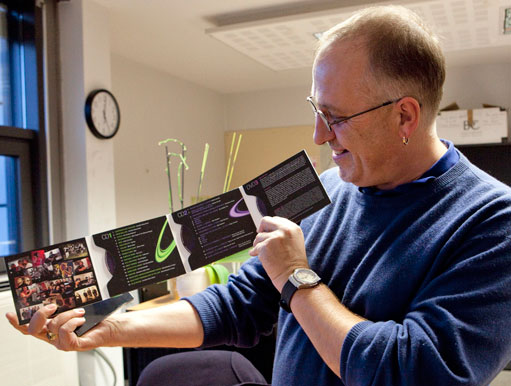
ATLAS e-News
23 February 2011
The sound of ATLAS – Resonance is here
30 November 2010

Around 3000 people work in the ATLAS Collaboration - physicists, engineers, technicians and support staff. Many of them are not only drawn together by their love of science, but are also passionate about playing music together. There are so many bands today in ATLAS and CERN that this year's Hardronic festival had to be extended from one to two days, to give all of the bands the opportunity to play.
But it's not just the quantity. In October 2008, the completion of the ATLAS detector construction was marked with a celebration that included a series of live performances and the guests were impressed by their quality. “That was the moment when the idea for Resonance was born,” explains Chris Thomas, the man behind the project. He organised the studio and found the companies for mixing the music tracks, creating the CD master, and printing the package. André-Pierre Olivier did the booklet, Matt Ryan and Neal Hartman the “Making of ” DVD. Chris participated to every single recording session – “Sometimes we spent 12 to 24 hours in the studio on the weekends, we used every evening or lunch break. Kiet Nguyen at Studio Jazzin in Geneva just took a nominal fee, because he wanted to support our project.” Chris remembers.
“Chris has done a fantastic job and the wealth of talent in ATLAS is absolutely amazing.” says ATLAS secretary and Canettes Blues Band singer Connie Potter.
The ATLAS management had an important part in it: Fabiola Gianotti, ATLAS Spokesperson is playing piano on the classical CD. “It's a nice challenge – a different one,” Fabiola explains in the DVD trailer.
“I volunteered to take part in the CD on a whim.” remembers Genevieve Steele, a Celtic harp player. “I'd never done any recording before so the studio was a little intimidating. Normally, when playing for a wedding, there is a lady in a big white dress who is the centre of attention. Here, all the attention was on me. My harp was being grumpy and going out of tune regularly, which panicked me even more. Eventually, we got it done with the aid of some persistent re-tuning for the harp and some liquid comfort to calm my nerves.”
Tomio Kobayashi, who commutes between Tokyo and Geneva recalls the recording experience as very enjoyable. Like many others, he had never entered a studio before, but was not nervous at all. “When I play, I forget everything around me,” he explains. He stood at the crossroad between music and science after finishing junior high school. “I decided to become a physicist,” he says with a smile “as being a hobby musician is much easier than being a professional musician and hobby scientist.” Tomio plays the clarinet with two professional musicians from the Mozarteum in Salzburg. “I met Peter Ovtcharov at a dinner in Tokyo and we played clarinet and piano together. When he invited me to Salzburg, he introduced me to Peter Langgartner and we decided to play together just for fun, whenever the occasion arose. Last year in June, I received the invitation for the CD and I asked the two Peters if they could come. We were not a band and had no name. The name “Collider Trio” was the violist Peter Langgartner's idea after I showed them around ATLAS. I like the name very much, it just fits.”
The Collider Trio is not the only international band who just came together to play for the CD. Another band featured on the ATLAS CD is the TLA, a group that brought together musicians from Melbourne and Freiburg. “Actually the band is pretty much a one off for the ATLAS CD. My main band is the Roadside Poppies, now based in Copenhagen, and we couldn't afford to get them over for the recording.” explains Martin White. “Instead, I thought it would be better to make a true band of physicists who had never played together before and see what came out.”
“I wanted to do something ATLAS-themed if we could. Everyone I knew was complaining about the number of meetings at the time, and I suddenly got a vision of the future where every major life event would happen without me. The song “Points of order“, is a gentle encouragement for hard working physicists to go home and see the family. That's what they'll worry about on their deathbed, not the axis labels on a histogram they did 40 years ago.”
The double album crosses all styles of music from classical to folk, from blues and hard rock to love songs. Singer-songwriter Cat Demetriades appears with her song “Sweet Cernoid”. “The recording was the greatest day in my life – just to be a part of it.”
The proceeds from sales of the ATLAS Resonance CD will go to the Happy Children's Home in Pokhara, Nepal, founded by Mette Stuwe, a former CERN staff member. When she visited Nepal in 2008, she decided to do something to better the extremely difficult living conditions, particularly those of the children, who have very little to eat and hardly any chance of ever attending school. She started building an orphanage, which is now home to four children and continues to expand.
The official world-wide release day of the ATLAS Resonance CD will be the 6th December but a lot of press interest has already been shown following the press release on 15th November. More details on the Resonance site.
More photos in this week's gallery.
 Birgit EwertATLAS e-News
|